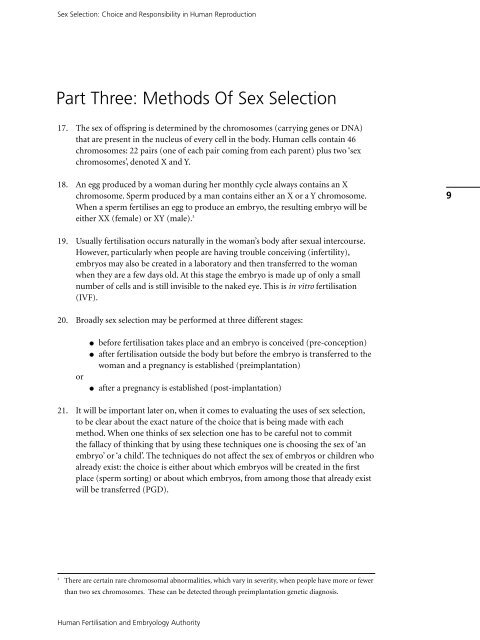Sex selection: choice and responsibility in human reproduction ...
Sex selection: choice and responsibility in human reproduction ...
Sex selection: choice and responsibility in human reproduction ...
You also want an ePaper? Increase the reach of your titles
YUMPU automatically turns print PDFs into web optimized ePapers that Google loves.
<strong>Sex</strong> Selection: Choice <strong>and</strong> Responsibility <strong>in</strong> Human ReproductionPart Three: Methods Of <strong>Sex</strong> Selection17. The sex of offspr<strong>in</strong>g is determ<strong>in</strong>ed by the chromosomes (carry<strong>in</strong>g genes or DNA)that are present <strong>in</strong> the nucleus of every cell <strong>in</strong> the body. Human cells conta<strong>in</strong> 46chromosomes: 22 pairs (one of each pair com<strong>in</strong>g from each parent) plus two ‘sexchromosomes’, denoted X <strong>and</strong> Y.18. An egg produced by a woman dur<strong>in</strong>g her monthly cycle always conta<strong>in</strong>s an Xchromosome. Sperm produced by a man conta<strong>in</strong>s either an X or a Y chromosome.When a sperm fertilises an egg to produce an embryo, the result<strong>in</strong>g embryo will beeither XX (female) or XY (male). 3919. Usually fertilisation occurs naturally <strong>in</strong> the woman’s body after sexual <strong>in</strong>tercourse.However, particularly when people are hav<strong>in</strong>g trouble conceiv<strong>in</strong>g (<strong>in</strong>fertility),embryos may also be created <strong>in</strong> a laboratory <strong>and</strong> then transferred to the womanwhen they are a few days old. At this stage the embryo is made up of only a smallnumber of cells <strong>and</strong> is still <strong>in</strong>visible to the naked eye. This is <strong>in</strong> vitro fertilisation(IVF).20. Broadly sex <strong>selection</strong> may be performed at three different stages:or●●●before fertilisation takes place <strong>and</strong> an embryo is conceived (pre-conception)after fertilisation outside the body but before the embryo is transferred to thewoman <strong>and</strong> a pregnancy is established (preimplantation)after a pregnancy is established (post-implantation)21. It will be important later on, when it comes to evaluat<strong>in</strong>g the uses of sex <strong>selection</strong>,to be clear about the exact nature of the <strong>choice</strong> that is be<strong>in</strong>g made with eachmethod. When one th<strong>in</strong>ks of sex <strong>selection</strong> one has to be careful not to committhe fallacy of th<strong>in</strong>k<strong>in</strong>g that by us<strong>in</strong>g these techniques one is choos<strong>in</strong>g the sex of ‘anembryo’ or ‘a child’. The techniques do not affect the sex of embryos or children whoalready exist: the <strong>choice</strong> is either about which embryos will be created <strong>in</strong> the firstplace (sperm sort<strong>in</strong>g) or about which embryos, from among those that already existwill be transferred (PGD).3There are certa<strong>in</strong> rare chromosomal abnormalities, which vary <strong>in</strong> severity, when people have more or fewerthan two sex chromosomes. These can be detected through preimplantation genetic diagnosis.Human Fertilisation <strong>and</strong> Embryology Authority
















